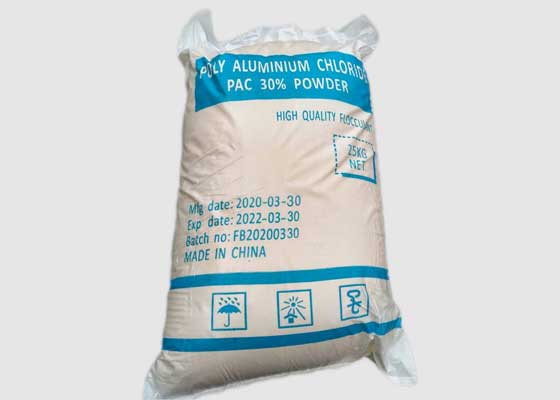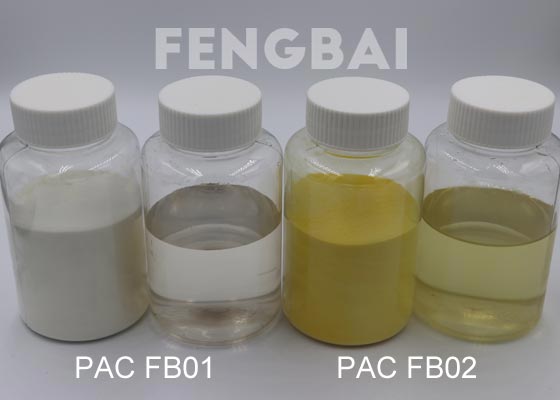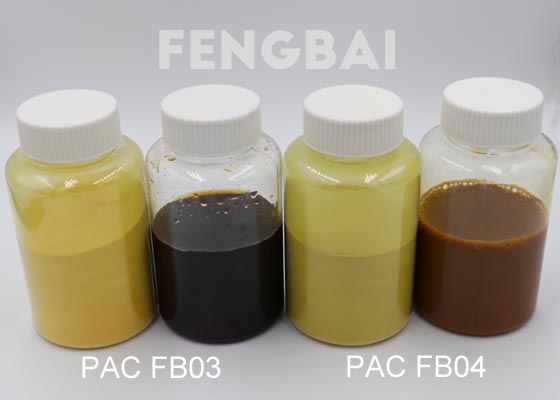


PAC Water Treatment Chemical
- CAS No: 1327-41-9
- HS Code: 28273200
- MF: {AL2 (OH) nCL6-n} m
- AL2O3 %: ≥30, ≥28
- Appearance: White, yellow powder
- Application Fields: Drinking water treatment, industrial wastewater treatment
- Package: 25 kgs PP bag;20 kgs PE bag; Ton bag
- MOQ: 1FCL
| Item | Type | |||
| PAC FB01 | PAC FB02 | PAC FB03 | PAC FB04 | |
| Standard | GB15892-2009 | GB-T 22627-2008 | ||
| Appearance | White powder | Light yellow powder | Yellow powder | |
| Application | Drinking Water | Industrial Waste water | ||
| AL2O3 % | ≥30 | ≥30 | ≥30 | ≥28 |
| Basicity % | 40-60 | 70-85 | 50-90 | 50-90 |
| PH value (1% aqueous solution) | 3.5-5.0 | 3.5-5.0 | 3.5-5.0 | 3.5-5.0 |
| Water insoluble % | – | ≤0.1 | ≤0.5 | ≤1.5 |
| Packing | 25 kgs PP bag;20 kgs PE bag; Ton bag | |||
| Storage | They shall be sealed and stored in the dry and ventilated place to prevent from rain, high temperature and strong sunlight. | |||
Inquiry Us for Quotation Here
Leave your requirements in detail here(including the specifications, package, quantity, country, etc.), we will reply you quickly.
SEND US EMAILGET PRICE NOWWhat Are Uses of PAC For Water Treatment
- PAC for drinking water treatment
- PAC for wastewater treatment
Poly aluminium chloride drinking grade is a new type of inorganic polymer water purifier with white or light yellow appearance. It is widely used in various water treatment plants and circulating treatment of domestic drinking water. PAC for drinking water is very safe to use.
There are some differences between PAC for drinking water treatment and PAC for wastewater treatment. They have different colors, and the AL203 content of drinking water PAC is about 30%, higher than that of industrial water treatment PAC. Drinking water has very strict safety requirements, and the heavy metal content of drinking water is extremely low. PAC FB01 and PAC FB02 are good-quality drinking water PAC that contains almost no heavy metals.
PAC water treatment chemical can be used for the treatment of domestic sewage and various industrial wastewater, such as printing and dyeing wastewater, leather wastewater, fluorine-containing wastewater, heavy metal wastewater, oily wastewater, papermaking wastewater, coal washing wastewater, mine wastewater, brewing wastewater, metallurgical wastewater, meat processing wastewater, etc.
PAC for comestic sewage treatment. Domestic sewage is wastewater directly discharged by residents in their daily lives, and the main components are feces and washing wastewater. The content of nitrogen, sulfur, and phosphorus in domestic sewage is relatively high. In order to remove a large amount of cellulose, starch, sugar, fat protein and other organic matter in the water, a special process needs to be used in the treatment. The coagulation process needs to use polyaluminum chloride for pretreatment to precipitate larger impurities in the water. However, polyaluminum chloride can’t completely remove the micro-suspended particles in water, so it is necessary to use cationic polyacrylamide to precipitate the micro-suspended particles. When treating wastewater and washing wastewater generated from daily domestic water, oily dirt and dust particles interact with a large amount of surfactants in the water to form negatively charged colloidal particles, which are easy to be fixed and retained in the water. Adding an appropriate amount of polyaluminum chloride to the wastewater will produce positively charged cations and multi-nuclear high-charge coordination ions, which can make the charges suspended on the surface of the colloidal particles have the ability to adsorb and neutralize and compress the electric double layer.
PAC for hospital wastewater treatment. Hospital wastewater contains a lot of organic compounds, if not treated in advance, it will cause harm to the environment. The coagulation method can be used in the sewage treatment plant to carry out the physical and chemical treatment of hospital wastewater. The coagulation method requires the coagulant to minimize the organic content in the water treatment. It is recommended to use PAC coagulant in the coagulation process of hospital wastewater.
PAC for wastewater treatment in paper mills. The black liquor produced in the paper industry is pretreated and mixed with the intermediate water for treatment, and then the harmful substances in the papermaking wastewater are added. Polyaluminum chloride used to treat mid-stage water in papermaking, due to the addition of basicity, the removal rate of COD and SS will also be added, but when the basicity reaches 75%, the removal rate won’t be added but will decrease. According to certain standards, the use of polyaluminum chloride to treat papermaking wastewater can make the effluent reach the national discharge standard, and it will not cause secondary pollution.
PAC for wastewater treatment in printing and dyeing industry. Printing and dyeing wastewater contains a large amount of COD, PH value and chroma. Although the coagulation effect of polyaluminum chloride is good during use and the dosage is relatively low, polyaluminum chloride has poor neutralization ability to the high alkalinity of printing and dyeing wastewater, and its application will also be limited. Using the complementary advantages of the two coagulants and the synergistic effect of the same ion effect to treat printing and dyeing wastewater can not only reduce the treatment cost, but also improve the treatment effect.
PAC for oily wastewater treatment. Oily wastewater refers to oily wastewater discharged from oilfield extraction water, oil refineries and petrochemical plants. It can be treated with oil separation sedimentation, air flotation and biochemical treatment. Modified cationic polyacrylamide and polyaluminum chloride are used together, and the treatment effect is particularly obvious. The relative molecular weight of modified cationic polyacrylamide should not be too high, and it is easy to compound with PAC wastewater treatment to achieve the desired effect.
PAC for water treatment also has a phosphorus removal effect. It can form deposits with phosphate radicals in wastewater, and is suitable for phosphorus removal in sewage plants. Polyaluminum chloride is usually used as a coagulant. Due to the different effects, the concentration of the solution and the dosage are very different. The dosage can be determined according to the turbidity of the raw water by doing a small product test.
PAC in wastewater treatment has a significant effect. By adding pac water treatment to the wastewater treatment process, it can remove suspended substances, acids, alkalis, organic matter, and other harmful substances contained in chemical wastewater. Due to the complexity of chemical wastewater treatment, in the process of using polyaluminum chloride, sometimes other water purification chemicals are required to cooperate with use, such as polyacrylamide, activated carbon, etc. By combining the use of pac chemical and other water purification chemicals, the color, odor, grease, heavy metals, etc. in the chemical wastewater can be removed more cleanly.
Inquiry Us for Quotation Here
Leave your requirements in detail here(including the specifications, package, quantity, country, etc.), we will reply you quickly.
SEND US EMAILGET PRICE NOWMore Information About PAC for Water Treatment
PAC for water treatment is an inorganic polymer coagulant with properties of adsorption, coagulation and precipitation. PAC coagulant powder is generally white, yellow and tan in appearance. Different colors of polyaluminum chloride in application and production process are very different. White PAC 30% is with high purity, which is usually used for drinking water treatment. Different production materials and processes directly affect the color and use of this chemical. Spray drying polyaluminum chloride has better water solubility, and the purification effect is more obvious. Fengbai PAC chemical are all made by the most advanced spray drying process at present. Choose the model suitable for you and inquiry us for price now.
- PAC coagulant has large molecular structure, strong adsorption capacity, low dosage and low processing cost.
- Good solubility, high activity, large alum blooms formed by agglomeration in water, rapid sedimentation, and purification capacity 2-3 times greater than other inorganic flocculants.
- Strong adaptability, less affected by the pH value and temperature of the water body. After purification, the raw water reaches the national drinking water standard, and the content of anions and cations in the treated water is low, which is conducive to ion exchange treatment and the preparation of high-purity water.
- Low corrosiveness and easy operation.
PAC coagulant can strongly adsorb on the surface of colloidal particles and suspended solids, promote particle flocculation through adhesion, bridging, cross-linking and sweeping. At the same time, it is accompanied by a series of physical and chemical changes. It can neutralize the surface of colloidal particles and suspended solids, reduce the Zeta potential of the colloid. The original repulsion turns into mutual attraction. Thus, the stability of the micelle is destroyed, and the micelle particles collide with each other to form a flocculant precipitate. The flocculant sediment has a large surface area and a relatively high adsorption capacity. The formed flocs are dense and the settling speed is fact, so that the purpose of water purification can be achieved.
The structure of PAC water treatment is composed of multiple carboxyl complexes with variable morphology. It has a fast flocculation and sedimentation speed, a wide applicable pH range, non-corrosive to pipeline equipment, and has an obvious water purification effect. PAC water treatment is widely used in drinking water and wastewater treatment.
PAC liquid is in an undried form and has the advantages of no need to be diluted, easy to load and unload, and relatively cheap. PAC powder is the dried form of liquid PAC, which has the advantage of convenient transportation. But it needs to be diluted when used.
- Store in a dry, non-direct sunlight, well-ventilated warehouse. Do not store with strong alkaline chemicals.
- The liquid PAC is transported to the warehouse in a tanker or packaging barrel, and can be directly added as needed during use.
When PAC powder is used, it is diluted with water to form a solution with an alumina content of 5%-15% according to actual needs, and is added through the dosing system or directly added to the water to be treated. The specific dilution method is as follows: pour clean water into the dissolution tank and pool according to the calculated amount, and turn on the stirring. Pour the PAC powder into the water according to the calculated amount and keep stirring until the product is completely dissolved. The solution obtained at this time can be added to the water to be treated or stored for use.
Buy Spray Drying PAC Water Treatment from Fengbai
- Since its establishment, Fengbai has been focusing on the development and production of PAC water treatment chemicals. With years of development, we have established a number of fully automatic production lines. Now we can supply 40000 tons of drinking water grade PAC and 30000 tons of industrial water grade PAC each year. Our productivity can ensure the timely supply of products, so that the goods can reach customers as quickly as possible.
- Fengbai company has already passed the quality authentication of ISO9001, HACCP, KOSHER and HALAL etc. Many customers establish long-term cooperation with us because of our high-quality products, good service, and timely delivery.
- If you are looking for spray drying PAC for water treatment or other water treatment chemicals for your business, please feel free to contact us at any time. We will reply to you as soon as possible.
